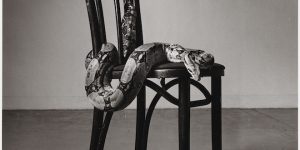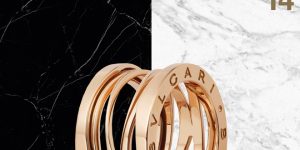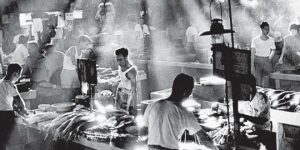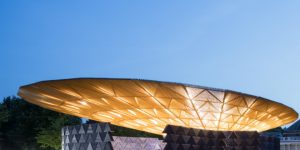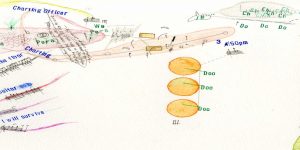Chinese artist Wu Jian’an at ArtScience Museum Singapore
Wu Jian’an explores traditional Chinese folk tales in Bulgari’s ‘Serpentiform’ exhibition, showing at the ArtScience Museum

Wu Jian’an, ‘Continuum – Generation by Generation’, 2017
Magic, mysticism and mythology — in these lie the essence of Chinese artist Wu Jian’an’s distinctive paper-cut creations. Wu’s fascination with the ancient and mystical is evident in his works, many of which are rooted in dreams and legend.
In the conclusive piece to his seven-part series based on a Chinese folk tale, ‘The White Snake Hid Immediately’, the titular white snake is coiled into a reverse pyramid, a helix of coloured wax amidst a white canvas of intricate cutouts. On display at Bulgari’s ‘Serpentiform’ exhibition at the ArtScience Museum, it is easy for the viewer to get lost in the painstaking intricacy of the medium. But paper cut, which makes up much of Wu’s oeuvre, holds much more than simple beauty.

Wu Jian’an, ‘The White Snake Hid Immediately’, 2017
Art Republik speaks with Wu Jian’an to find out more about the traditional Chinese technique he uses, the mythologies behind them, and what he has in store for the future.
For most of your works, you use the traditional Chinese paper cut medium, paired alongside unconventional materials such as oxhide, brass and stainless steel. What’s the reason behind your choice of medium, and what is the biggest challenge in creating your artworks?
Today, when we think of paper cutting, it’s just like drawing or painting, or any other kind of art. But paper cut has traditionally had a relationship with magic. In the old days, it was used to bring back souls from the dead, or to heal the sick. There’s a mysterious energy in the medium, and I was attracted to that.
Every medium has its challenges. Paper cut is special because in order to get the image you want, you have to remove parts of it. It’s an immensely controlled technique that requires patience and careful thought. But sometimes, you want to express an intense, strong emotion, and that’s difficult with paper cut because you have to translate that into something slow, delicate and controlled.

Wu Jian’an, ‘The face of herring has transformed into a human face with golden sighted eyes’
Mythical animals feature heavily in your works — in ‘Omens’, for example, and also here in Serpentiform where you explore the snake, a powerful symbol in Chinese mythology. What ideas do you explore through them?
Sometimes we see strange things. For many people, these anomalies are a source of fear or disdain. There’s a system in a world, a proper construct, and these irregularities defy that. But for me, these strange things — these monsters — are a key to something else. And while I may not know where the door is, or what lies beyond the door, I know that these things are incredibly important. So if a strange image appears in my imagination or in front of my eyes, I feel a need to capture it in my work and my stories.
Your works often reference ancient Chinese legends and tales. Is there a story behind this?
In the beginning, it was because of fear. As a child in China, I read these folk tales about these strange and mystical beasts, and I was both terrified and enchanted by them. I guess I’m the kind of person who doesn’t forget easily. I have carried those memories until now, and I use my work to express those strong feelings from my past.
Also, I believe mythology is the root of human civilisation. These stories that are told generation after generation, about heroes and heroines, adversaries and ghosts. They inspire us, and we design our attitudes based on them.
For example, in China, most of our stories are set on land. In Greece, they have many stories about the ocean and, traversing the seas, and after two thousand years, their grandsons go to Asia and South America, searching for new land. But the Chinese still remain on land.

Wu Jian’an, ‘Omens’, 2015-16
Speaking of which, tell me more about your work in Bulgari’s Serpentiform exhibition, ‘The White Snake Hid Immediately’. Is it a reference to the Legend of the White Snake (白蛇传)? If not, what was the inspiration behind the piece, and how did you go about creating it?
Yes. The Legend of the White Snake is one of the most important folk tales in China, and it is at its core a love story. But there are some parts that I felt were unclear. For example, why does the monk try and keep the White Snake and the man apart? Because they did have a happy life together, and the snake did not want to kill the boy or harm him in any way.
So is it because, as the legend says, that the monk did not believe it was right for a beast to marry a human? No, I don’t think so. In Chinese folk mythology, there are many of these marriages. So what was the reason? There must be one, but it wasn’t mentioned in the original tale. And so I came up with my own.
My work has seven panels. Put together, the images tell the full story. ’The White Snake Hid Immediately’ is the conclusion.

Wu Jian’an, ‘The White Snake Hid Immediately’ (detail view), 2017
Just now, you gave a talk to the students at LASALLE College of the Arts, Singapore, and you’re also an associate professor with the Central Academy of Fine Arts in Beijing. Is it important for you to share your work with the next generation of artists, especially considering its roots in tradition?
Of course. In school, we always discuss tradition, and why we need it. In this day and age, we see plenty of new, interesting things. Some of them may last, and others may not. But in tradition we see and learn about the things that have already withstood the test of time.
As artists, no one wants their work to be shown for just one day. We all want our creations to be shown for a long time, to communicate and express our messages and emotions to many people. Through tradition, we learn how to infuse longevity in our works and creations.

Wu Jian’an, ‘Continuum – Generation by Generation’, 2017
Is there anything we can look forward to in the future? Perhaps an upcoming exhibition?
Right now, I’m working on a new project for next spring. It’s inspired by the Miao nationality, a Chinese ethnic group from Southwest China. They have special folk tales and powerful, interesting mythologies. The project will incorporate elements of their mythology and handcraft techniques into a new, original story, which will explore the concept of immortality.
The first stop will be Prince Gong’s Palace in Beijing, and then we’ll travel to other art museums and galleries along the way.
‘The White Snake Hid Immediately’ by Wu Jian’an will be on display at Bulgari’s ‘Serpentiform’ exhibition at the ArtScience Museum until 15 October, as part of a joint effort between Bulgari and Asia Art Initiative.
Read more about the exhibition at http://www.luxuo.com/culture/art/serpentiform-snake-through-art-jewellery-and-design-exhibition-at-artscience-museum-singapore.html.
Ilyda Chua




